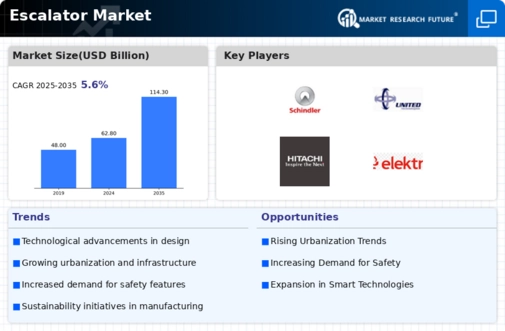Escalator Size
Escalator Market Growth Projections and Opportunities
The Escalator Market is influenced by various factors that contribute to its dynamics and growth. A significant driver is the rapid urbanization and increased construction of commercial and residential buildings, shopping malls, airports, and metro stations globally. Escalators, as a key vertical transportation solution, play a crucial role in efficiently moving people between different levels of these structures. The growing demand for convenient and time-saving transportation within buildings propels the expansion of the escalator market.
Raw material availability and pricing play a crucial role in the escalator market. The primary materials for manufacturing escalators include steel, aluminum, and various composite materials. Fluctuations in the prices of these raw materials, influenced by factors such as steel tariffs, supply chain disruptions, and market demand, can impact the overall production cost of escalators. Ensuring a stable and cost-effective supply of high-quality materials is essential for manufacturers to maintain competitiveness in the market.
Technological advancements in escalator design and safety features contribute to market growth. Innovations in drive systems, control mechanisms, and safety sensors lead to the development of escalators with improved energy efficiency, reliability, and passenger safety. Continuous research and development in the industry drive advancements, expanding the applications of escalators in various sectors and influencing the market's expansion.
End-user industries significantly influence the demand for escalators. The commercial and public transportation sectors, including shopping centers, airports, metro stations, and office buildings, are major contributors to the escalator market. Additionally, the residential sector increasingly adopts escalators for homes and condominiums. Companies in the escalator sector need to understand the specific requirements of these end-user industries to tailor their products accordingly and meet market demands.
Global economic conditions and trade policies also play a role in shaping the escalator market. Changes in international trade agreements, tariffs, and geopolitical factors can impact the supply chain, affecting both producers and consumers. Companies in the market must navigate these global economic dynamics to ensure stability in their operations and explore new opportunities in emerging markets.
Environmental considerations and energy efficiency are gaining importance in the escalator market. As sustainability becomes a key focus across industries, there is a growing demand for escalators with energy-efficient features and eco-friendly materials. Companies adopting green manufacturing practices and promoting the environmental benefits of their escalators can gain a competitive edge.
Consumer preferences for safety, comfort, and aesthetics influence the escalator market. Building owners and developers seek escalators that provide smooth and secure transportation, enhance the overall building design, and offer a positive user experience. Companies that prioritize innovative design, comfort features, and safety technologies can attract a broader customer base.
Weather conditions and climate considerations may impact the escalator market, especially in outdoor installations or regions prone to extreme weather events. Companies need to design and manufacture escalators that can withstand varying environmental conditions and ensure reliable performance in adverse weather.








Leave a Comment